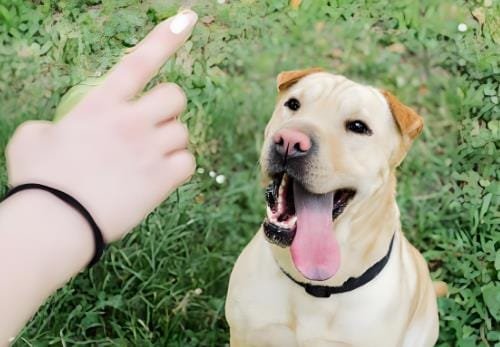
Obedience Training for Dogs: 5 Easy Cues to Master
5 Simple Cues Every Dog Should Learn (and How to Teach Them)
Training your dog isn’t just about good manners—it builds trust and communication. These five cues are practical, easy to master, and lay the foundation for more advanced skills.
1. Sit
Why it matters: Instantly redirects hyper behavior and encourages calmness.
How to teach:
Hold a treat near your dog’s nose, then slowly lift it upward.
As their head follows the treat, their butt will naturally lower.
Say “Sit” the moment they hit the ground, then reward.
Pro tip: Practice before meals when your dog is motivated by food.
2. Down
Why it matters: Helps manage excitement and is useful for vet visits or crowded areas.
How to teach:

Start with your dog in a “sit.”
Lower a treat to the floor between their paws, saying “Down” as they stretch toward it.
Reward only when their elbows touch the ground.
Watch for: Some dogs resist lying down—stay patient and avoid pushing their shoulders.
3. Stay
Why it matters: Keeps your dog safe in risky situations (e.g., open doors).
How to teach:

Ask your dog to “Sit” or “Down.”
Hold your palm out like a stop sign, say “Stay,” then take ONE step back.
Immediately return, reward, and release with “Okay!”
Build gradually: Increase distance/duration over weeks—never rush this skill.
4. Come
Why it matters: A reliable recall could save your dog’s life.
How to teach:
Leash your dog indoors. Say “Come” cheerfully while gently pulling the leash toward you.
When they move your way, shower them with treats/praise.
Game-changer: Never call to scold—make coming to you the best part of their day.
5. Leave It
Why it matters: Prevents swallowing dangerous items during walks.
How to teach:
Show a treat in your closed hand. Let your dog sniff/lick it.
When they stop trying, say “Leave it” and reward with a DIFFERENT treat from your other hand.
Level up: Practice with low-value items on the floor, covering them with your foot if needed.
Training Rules Most Owners Forget
Keep sessions short: 5-10 minutes, 2-3x daily. Dogs learn better in bursts.
Phase out treats slowly: Once they nail the cue 90% of the time, reward randomly.
Use real-life rewards: After “Sit,” reward by opening the door for a walk—not just with food.
Troubleshooting FAQ
“My dog listens at home but ignores me outside!”
→ Practice in distracting areas ON LEASH first. A 15-foot training leash works great for parks.
“He knows ‘Down’ but won’t do it unless I have treats!”
→ Hide treats in your palm sometimes and reward from a pouch other times. Keep them guessing.
Consistency beats talent—stick with it, and you’ll see results. What cue are you working on first?
American Dingo animal behavior Budget Tips canine behavior Canine Care Canine Health DIY pet projects dog behavior Dog Breeds dog care Dog Care Tips dog exercise Dog Food Dog Grooming dog health Dog Measurement dog nutrition dog ownership dog potty area Dog Training Dog Wound Care Family Pets Hunting Dogs lipomas in dogs newborn puppy care obedience training outdoor pet care Pet Care Pet Care Tips Pet Health Pet Loss Pet Safety pet tips pet training Positive Reinforcement Potty Training Puppy Care puppy health Puppy Training Rabies in Dogs Temperature Monitoring Training Tips veterinary advice Veterinary Care Veterinary Tips
-
 Daylight Saving Time & Dogs: Vet-Reviewed Effects on Canine Sleep, Behavior & Adjustment Tips
7 views
Daylight Saving Time & Dogs: Vet-Reviewed Effects on Canine Sleep, Behavior & Adjustment Tips
7 views -
 13 Must-Know 2025 Pet Hotel Stats: Market Boom, Profit Margins & Future Trends Revealed
3 views
13 Must-Know 2025 Pet Hotel Stats: Market Boom, Profit Margins & Future Trends Revealed
3 views -
 How to Identify an Australian Stumpy Tail Cattle Dog
3 views
How to Identify an Australian Stumpy Tail Cattle Dog
3 views -
 12 Must-Know 2025 Australia Pet Insurance Stats: Cost Shocks, Gen Z Trends & Vet Bill Survival Guide
3 views
12 Must-Know 2025 Australia Pet Insurance Stats: Cost Shocks, Gen Z Trends & Vet Bill Survival Guide
3 views -
 Caring for a Sensitive Dog: 11 Vet-Approved Strategies to Manage Anxiety & Build Trust (2025 Guide)
3 views
Caring for a Sensitive Dog: 11 Vet-Approved Strategies to Manage Anxiety & Build Trust (2025 Guide)
3 views -
 Dog Alopecia Guide: Vet-Backed Causes, Treatments & Prevention Tips (Breed-Specific Solutions)
3 views
Dog Alopecia Guide: Vet-Backed Causes, Treatments & Prevention Tips (Breed-Specific Solutions)
3 views -
 Labradoodle vs. Cockapoo: Understanding the Differences
2 views
Labradoodle vs. Cockapoo: Understanding the Differences
2 views -
 How to Teach Your Dog to Use the Restroom at a Designated Location
2 views
How to Teach Your Dog to Use the Restroom at a Designated Location
2 views -
 Dog Breeding Age Guide 2025: Optimal Timing for Females & Males (+ Vet-Approved Risks)
2 views
Dog Breeding Age Guide 2025: Optimal Timing for Females & Males (+ Vet-Approved Risks)
2 views -
 UK Pet Industry 2025: 15 Eye-Opening Stats Every Pet Lover Should Know
2 views
UK Pet Industry 2025: 15 Eye-Opening Stats Every Pet Lover Should Know
2 views










Leave a Reply
You must be logged in to post a comment.